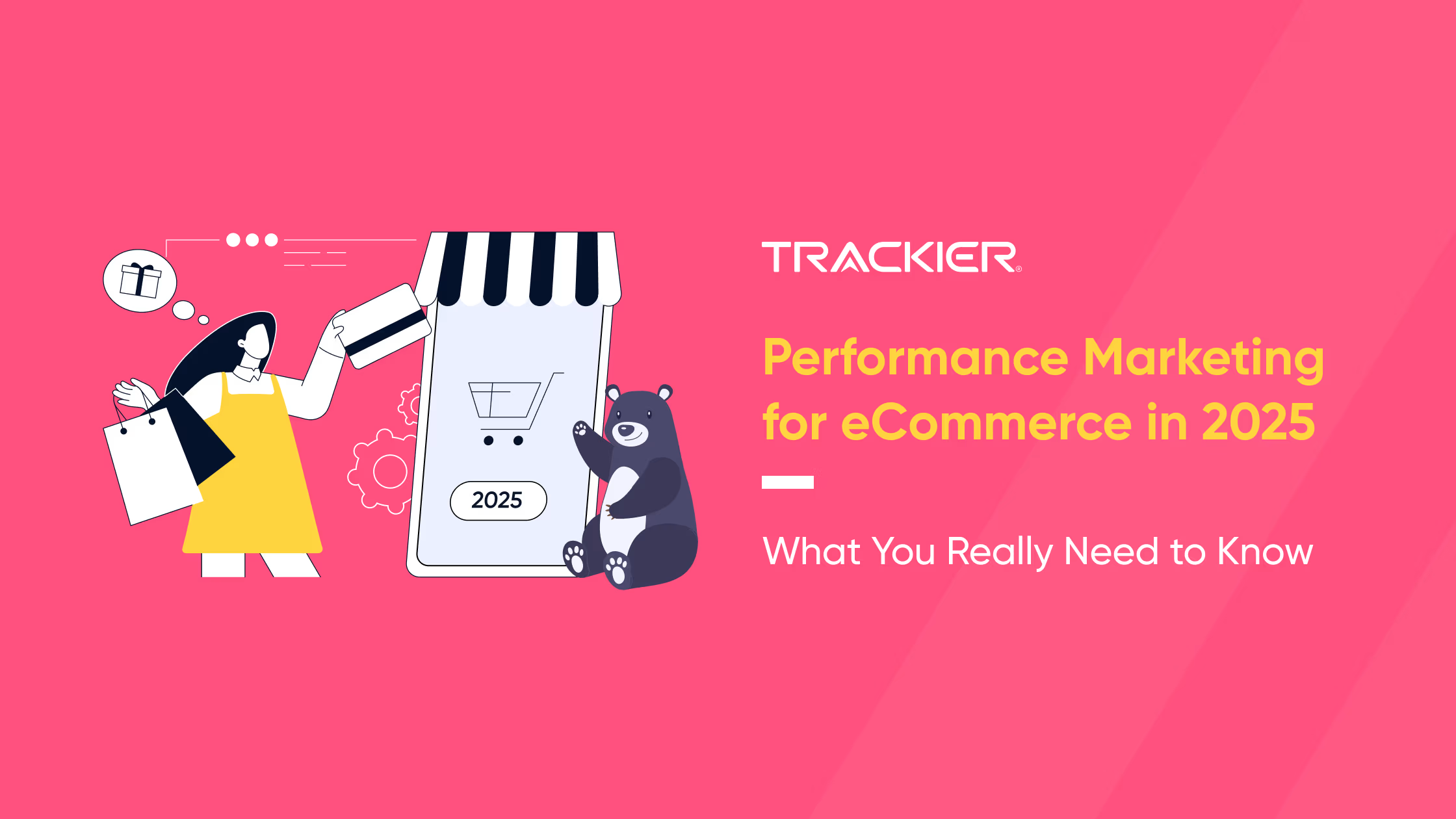In 2025, online shopping is expected to reach 21% of all retail sales worldwide, with e-commerce sales projected to reach $6.86 trillion. As the online market grows, businesses face tougher competition to attract and keep their customers.
E-commerce marketing strategy helps businesses to boost their online presence, and increase their ROI. However, to effectively execute this, they will need to leverage performance marketing software.
Trackier helps businesses to manage their marketing campaigns, monitor performance, and prevent fraud. By using Trackier, businesses can better understand customer behavior, make informed decisions, and stand out in the crowded e-commerce market.
What is E-commerce Marketing?
E-commerce marketing is a strategy to promote and sell products online. Brands leverage different performance marketing channels to increase visibility and drive traffic to their e-commerce stores.
The main goal? To attract potential customers by analyzing where they are spending most of their time on the internet. Here are some of the key components:
- Search Engine Optimization (SEO): To boost website organic traffic by doing on-page, off-page, and technical SEO.
- Content Marketing: Creating relevant content, such as blogs, videos, and infographics, with a flipbook creator to engage potential customers and establish brand authority.
- Social Media Marketing: Leveraging platforms like Facebook, Instagram, and X to promote products, interact with their customers, and build an engaging community.
- Email Marketing: Send personalized emails to their prospects and existing customers to inform them about new products, promotions, and updates.
- Pay-Per-Click Advertising (PPC): Running paid ads on search engines and social media platforms to drive immediate traffic and sales.
- Affiliate Marketing: Partnering with individuals or other businesses who promote your products in exchange for a commission on sales generated.
- Influencer Marketing: Collaborating with influencers who have a significant following to endorse products and reach a broader audience.
- Mobile Marketing: Optimizing marketing efforts for mobile devices to reach users through apps, SMS, and mobile-friendly websites.
How Does E-commerce Marketing Work?

E-commerce marketing leverages various digital channels to drive traffic, engage potential customers, and boost online sales. Here’s how it operates:
1. Building an Online Presence
Optimizing your website by ensuring it is user-friendly, mobile responsive, and fast-loading will enhance the overall shopping experience, reduce bounce rates, and boost conversions.
Additionally, businesses implement on-page and technical SEO strategies to improve search engine rankings, making e-commerce sites more discoverable to potential customers.
2. Driving Traffic Through Digital Channels
Content marketing involves creating valuable content like blog posts, videos, and infographics to attract and educate potential customers while establishing your brand as an industry authority.
Social media marketing leverages platforms like Facebook, and Instagram to engage audiences, build community, and brand loyalty, and drive traffic through targeted ads.
Meanwhile, email marketing uses personalized campaigns to keep audiences informed about new products, promotions, and updates, nurturing leads and encouraging repeat purchases.
3. Leveraging Affiliate Marketing
Partnering with affiliates, such as influencers, bloggers, and content creators, helps expand your product’s reach by leveraging their audience base. With Trackier’s affiliate tracking software, businesses can seamlessly manage these partnerships and ensure accurate commission payouts.
Affiliates will promote your products using unique tracking links, and with Trackier’s real-time marketing analytics, you gain valuable insights into their performance, conversions, and ROI.
4. Utilizing Data and Analytics
Tracking key metrics like traffic sources, conversion rates, and customer behavior helps assess the effectiveness of your marketing strategies.
While A/B testing different approaches like email subject lines or ad creatives identifying what resonates best with the audience helps to make data-driven decisions.
10 E-commerce Marketing Strategies to Increase Sales

Here are the top 11 e-commerce marketing strategies including social media advertising, updating your website, building a mobile app, etc that help businesses increase their sales and improve ROI.
1. Social Media Advertising
Advertising on social media helps e-commerce businesses to drive engagement, increase their brand awareness, and boost sales. As of February 2025, there were 5.56 billion internet users worldwide, which is around 67.9% of the global population. Of this total, 5.24 billion of the world’s population were social media users.
That said, social media advertising isn’t just about reaching a large audience, it is about targeting the right audience.
Many platforms use advanced AI-driven algorithms to help brands show their ads in front of people who are most likely to convert, based on their interests, behaviors, and demographics.
Each social media platform offers unique advantages for e-commerce brands:
- Facebook & Instagram Ads: Best for highly targeted ads and shoppable posts make it easy to convert users.
- TikTok Ads: Ideal for engaging younger audiences with short-form video content that boosts discovery. TikTok’s algorithm helps brands go viral quickly.
- Pinterest Shopping Ads: Great for lifestyle and fashion brands.
- LinkedIn Ads: Works well for B2B e-commerce, allowing businesses to target decision-makers and professionals.
2. Update Your Website
Your e-commerce website is your digital store. It is the first thing your potential customers view. If your website looks outdated or cluttered, visitors may doubt your credibility and leave before exploring your products. To stay competitive, it’s essential to keep your website visually appealing, user-friendly, and optimized for conversions.
Start by evaluating your website’s design against current e-commerce trends. A modern, clean, and intuitive layout instantly enhances user trust and engagement. If your site hasn’t had a refresh in years, consider a redesign to improve navigation, speed, and aesthetics.
Shoppers associate sleek, professional designs with reliability, while outdated websites can create doubts about security and legitimacy—even if your website is secure.
Speaking of security, an SSL certificate, secure payment gateways, and clear trust signals (like customer reviews and security badges) should be displayed on your website. Customers today are highly conscious of data privacy, and a website that doesn’t inspire confidence could result in lost sales.
Additionally, ensure your website is fully responsive and mobile-friendly. With a growing number of shoppers browsing on smartphones and tablets, a seamless experience across all devices is non-negotiable. Google also prioritizes mobile-first indexing, meaning a well-optimized mobile site can improve your search rankings and bring in more traffic. Integrating shoppable Instagram content into your website can further enhance user engagement and increase conversions by allowing visitors to browse and purchase products directly from your social media feed.
3. Build a Mobile App
Another effective way to enhance your e-commerce marketing strategy is by developing a mobile app. With mobile commerce (m-commerce) being accountable for a significant share of online sales, having a dedicated app provides a seamless and engaging shopping experience for your customers.
For established e-commerce brands, a mobile app offers many advantages over a traditional mobile website. Apps generally load faster, making browsing and purchasing more convenient. They also allow for a more personalized shopping journey by leveraging customer preferences, purchase history, and AI-driven recommendations.
One of the biggest benefits of a mobile app is push notifications. These real-time alerts help brands engage customers by notifying them about exclusive deals, sales, and personalized discounts. Additionally, apps can send stock alerts for products customers are interested in, improving retention and driving repeat purchases.
Loyalty programs and in-app rewards are another major advantage. Many successful e-commerce brands use gamification techniques within their apps, such as reward points, referral incentives, and VIP memberships, to keep customers engaged and encourage repeat business.
While building a mobile app requires investment, it can significantly boost customer loyalty and conversion rates. However, whether or not you develop an app, ensuring your website is mobile-responsive remains crucial.
With mobile shopping continuously growing, an optimized mobile experience—whether through an app or a well-designed website—is essential for staying competitive.
4. Upsell Your Products
Upselling is a smart e-commerce marketing strategy that encourages customers to purchase a higher-value version of the product they originally intended to buy. This tactic helps businesses increase their average order value (AOV) and maximize revenue from existing customers.
Since the probability of selling to an existing customer is significantly higher (60–70%) than acquiring a new one (5–20%), upselling can be a powerful growth driver for online stores.
How Upselling Works?
- Encouraging a customer to buy a higher-tier product with better features.
- Recommending an upgrade or premium version of the selected item.
- Offering bundles that enhance the value of the original purchase.
For example, if a customer is purchasing a basic smartwatch, an upsell might highlight a premium version with advanced health tracking, a longer battery life, and exclusive features.
5. Reduce Abandoned Carts
Shopping cart abandonment is one of the biggest challenges in e-commerce, leading to significant revenue loss for online retailers.
In fact, the global average shopping cart abandonment rate hovers around 70%–80%, with industries like fashion, electronics, and travel facing even higher drop-off rates.
While some level of cart abandonment is inevitable, businesses can minimize it by optimizing their checkout process, offering better incentives, and engaging customers at the right time.
How to reduce shopping cart abandonment?
- Simplify the Checkout Process: Reduce friction by offering a guest checkout option, auto-filling fields, and limiting the number of steps required to complete a purchase. A one-page checkout can significantly boost conversions.
- Be Transparent About Costs: Show shipping fees, taxes, and additional costs upfront to prevent sticker shock at the final step. Offering free shipping or discounts on minimum purchases can also help.
- Provide Multiple Payment Options: Support credit/debit cards, digital wallets (Apple Pay, Google Pay, PayPal), and Buy Now, Pay Later (BNPL) services.
- Use Exit-Intent Popups: When a visitor attempts to leave the checkout page, trigger an exit-intent popup offering a discount, free shipping, or a limited-time deal to entice them to complete the purchase.
- Send Abandoned Cart Emails & SMS: Set up automated cart recovery emails or SMS reminders through Trackier’s performance marketing tools. A well-timed message with a small discount or product recommendation can bring shoppers back.
- Leverage Retargeting Ads: Use retargeting campaigns on Google, Facebook, and Instagram to remind visitors of the products they left behind. Personalized ads with urgent messaging (e.g., “Only 3 left in stock!”) can drive conversions.
- Offer Live Chat Support: Sometimes, shoppers have last-minute doubts about a product, payment, or delivery. Live chat assistance at checkout can help answer queries in real-time and prevent drop-offs.
- Highlight Security & Trust Badges: Display trust seals, customer reviews, and secure payment icons at checkout to build confidence and assure shoppers their information is safe.
6. Show Shipping Costs
Unexpected shipping costs are one of the biggest reasons for cart abandonment in e-commerce. No matter how competitive your prices are, an unanticipated delivery fee at checkout can cause potential customers to leave without completing their purchase. This not only impacts your sales but also increases your website’s bounce rate.
The best approach? Transparency. Make sure shipping costs are clearly displayed early in the customer journey—whether on product pages, in the cart summary, or through a dedicated shipping information section. Relying solely on a delivery page isn’t enough, as not all customers will check it.
If your shipping costs vary, consider providing an estimate before checkout or using a shipping calculator to help customers make informed decisions. Another effective approach is offering a flat-rate shipping fee, which simplifies expectations and reduces friction during checkout.
Alternatively, free shipping can be a game-changer. Many e-commerce businesses absorb shipping costs within product pricing to make the offer more attractive. While this can boost conversions, keep in mind that repeat customers may notice price adjustments. A/B testing different pricing models can help determine what works best for your audience.
7. Make Your Checkout Process More Easier
Since we’ve established that cart abandonment is a major issue, simplifying the checkout process is crucial for increasing conversions. A complicated, time-consuming checkout experience can drive potential customers away at the final stage. Here’s how you can optimize it.
- Minimize the Steps in Checkout: Every additional step in the checkout process increases the likelihood of a customer dropping off. Consider reducing the number of required fields and steps to complete a purchase. Autofill options, one-click checkout, and saved payment details for returning customers can significantly speed up the process.
- Offer Guest Checkout: Many shoppers abandon their carts when they’re forced to create an account before making a purchase. While account creation is valuable for data collection and retargeting, it shouldn’t be a barrier to conversion. Allowing guest checkout ensures a frictionless experience, making it easier for first-time buyers to complete their purchase without hesitation.
- Optimize for Mobile Users: Mobile shopping continues to rise, yet many e-commerce sites still have checkout processes that are not mobile-friendly. Ensure that your checkout page is responsive, loads quickly, and has large, easy-to-click buttons for a seamless mobile experience.
- Provide Multiple Payment Options: Limited payment options can be another roadblock. Offer a variety of payment methods, including credit/debit cards, digital wallets (Apple Pay, Google Pay, PayPal), and even Buy Now, Pay Later (BNPL) options. The more flexibility you provide, the higher the chance of completing the sale.
- Show Transparency in Costs: Unexpected shipping fees and additional charges at checkout are among the top reasons for cart abandonment. Display all costs upfront, including taxes and shipping fees, and provide estimated delivery dates to build trust with your customers.
- Implement Auto-Save & Cart Recovery: A customer might leave mid-checkout due to distractions or second thoughts. By auto-saving cart progress and sending abandoned cart emails with incentives like discounts or free shipping, you can encourage them to return and complete the purchase.
- Ensure a Secure & Trustworthy Checkout: Customers need to feel confident when entering their payment details. Display trust signals such as SSL certificates, secure payment icons, and customer reviews. Offering secure checkout options reduces hesitation and boosts conversions.
8. Engage Visitors With Live Chat
Even with in-depth product descriptions, FAQs, and customer reviews, shoppers often have last-minute doubts that can make or break a sale. Live chat is the perfect solution to address these concerns in real-time, ensuring that visitors don’t abandon their carts due to unanswered questions.
Beyond just offering live chat as a support tool, e-commerce brands can strategically engage high-intent shoppers.
For example, if a visitor lingers on a product page for a while, a proactive chat message can offer assistance or highlight a limited-time discount. Similarly, targeting visitors who land on your site from a specific source—like an email campaign—can help personalize their experience and drive conversions.
Speed is key. Once a visitor starts a chat, responding quickly and knowledgeably can make all the difference. An efficient live chat system can significantly reduce bounce rates, improve customer satisfaction, and build brand loyalty.
Plus, integrating chatbots alongside human support can ensure 24/7 availability, keeping potential customers engaged no matter when they shop.
9. Email Marketing and Automation
While exploring new marketing strategies is essential, some traditional channels remain highly effective—one of the best examples being email marketing. Despite the rise of social media and paid ads, email marketing remains a cost-effective way to engage customers and drive conversions. After all, nearly every online shopper has an email address.
A great place to start is by building an email list. Encourage visitors to subscribe through pop-ups, exit-intent forms, or exclusive discounts on your e-commerce website. Subscribers who willingly sign up are already interested in your brand, making them highly engaged leads.
Why is e-mail marketing essential for e-commerce?
- Cost-effective Customer Engagement: Unlike paid ads, sending emails is relatively low-cost, with high ROI.
- Direct Communication Channel: Unlike social media, where algorithms control visibility, emails land directly in inboxes.
- Personalized Marketing: Segmentation and automation allow businesses to tailor messages based on user behavior.
That said, email automation takes e-commerce marketing a step further by ensuring timely, relevant engagement. Here’s how automation can enhance the customer journey:
- Abandoned Cart Emails: Many shoppers abandon their carts before completing a purchase. Automated cart recovery emails remind them about their pending orders, sometimes with a limited-time discount or free shipping incentive to drive conversions.
- Welcome Email Sequences: When customers subscribe, an automated welcome series can introduce them to your brand, highlight bestsellers, and even offer a first-purchase discount.
- Order Confirmation & Shipping Updates: Transactional emails (order confirmations, shipping details, and delivery updates) reassure customers and improve trust in your brand.
- Re-engagement Emails: If customers haven’t shopped in a while, win-back campaigns with personalized product recommendations or loyalty points can bring them back.
- Product Review & Upsell Emails: Post-purchase emails requesting reviews or offering complementary product recommendations can increase customer lifetime value.
10. Provide a Personalized Buying Experience
Personalization is at the heart of modern e-commerce marketing. Today’s customers expect brands to understand their preferences and offer relevant recommendations. In fact, 60% of shoppers are more likely to become repeat buyers if they have a personalized shopping experience.
Take inspiration from platforms like Netflix, which recommend content based on past viewing history. Similarly, e-commerce brands can enhance the buying journey by tailoring product recommendations, special offers, and content to each customer’s interests Whether you’re a brand or a content creator. The goal is simple: remove friction from the buying process and make it easier for customers to find what they need.
How does personalization enhance the shopping experience?
- Email Marketing & Retargeting: Personalized email campaigns that suggest products based on browsing history, past purchases, or abandoned carts help re-engage potential buyers.
- AI-Powered Product Recommendations: Displaying “Recommended for You” sections on your website based on customer behavior can increase conversions.
- Geo-Targeted Offers: Customizing promotions based on a customer’s location improves relevance and engagement.
- Exclusive Discounts & Loyalty Programs: Rewarding repeat customers with tailored discounts builds brand loyalty.
Conclusion
In conclusion, e-commerce marketing in 2025 is more competitive than ever, requiring businesses to adopt strategic approaches to attract and retain their customers. Leveraging performance marketing software like Trackier helps brands to optimize their campaigns, analyze customer behavior, and prevent fraud, ensuring maximum ROI.
By implementing tactics such as social media advertising, mobile optimization, and affiliate marketing, businesses can drive traffic, increase conversions, and enhance their customer experiences. As online shopping continues to grow, staying ahead with data-driven insights and innovative strategies will be crucial for success in the evolving e-commerce industry.








